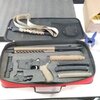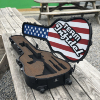wichta5003
Member
I'm trying to convert a guitar case into an AR-15 case. Can anyone here tell me where I can buy the kind of foam rubber that pulls apart into little cubes? I'm going to need to get chunks of the stuff large enough so I can make it form-fit into both of the halves of the case, and then start plucking out the cubes to allow my AR-15 inside.
Unless there's a better way to do it... in that case, I'm all ears...
Thanks in advance...
Unless there's a better way to do it... in that case, I'm all ears...
Thanks in advance...














